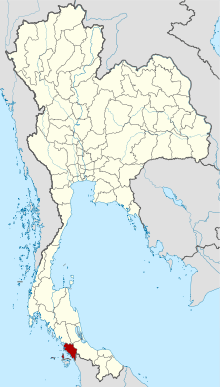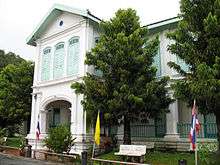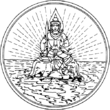Satun Province
| Satun สตูล | ||
|---|---|---|
| Province | ||
|
| ||
| ||
 Map of Thailand highlighting Satun Province | ||
| Country |
| |
| Capital | Satun | |
| Government | ||
| • Governor | Phatthraphon Rattanaphichetchai (since October 2015) | |
| Area | ||
| • Total | 2,479 km2 (957 sq mi) | |
| Area rank | Ranked 63rd | |
| Population (2014) | ||
| • Total | 312,673 | |
| • Rank | Ranked 69th | |
| • Density | 130/km2 (330/sq mi) | |
| • Density rank | Ranked 45th | |
| Time zone | ICT (UTC+7) | |
| ISO 3166 code | TH-91 | |
Satun (Thai: สตูล, pronounced [sā.tūːn]) is one of the southern provinces (changwat) of Thailand. Neighboring provinces are (from north clockwise) Trang, Phatthalung, and Songkhla. To the south it borders Perlis of Malaysia.
Etymology
The name Satun is a Thai version of its original Malay name, Setul (santol, or wild mangosteen tree).
Geography
The province is on the Malay Peninsula, on the shore of the Andaman Sea. It is separated from Songkhla Province by the Nakhon Si Thammarat mountain range, and from Malaysia by the Sankalakhiri mountains.
The Ko Tarutao and Ko Phetra marine national parks are part of the province. Close to the border with Malaysia is the Thale Ban National Park, a big freshwater swamp area.
History
Until 1813 Satun was a district of the Malay state of Kedah, then known as Setul Mambang Segara or Mukim Setul (Jawi: مقيم ستول) in Malay. After that date it was administered by a governor sent from Nakhon Si Thammarat. In 1897 Satun became part of Monthon Saiburi (now Kedah), which in 1909 was divided between British Empire and Siam as part of Anglo-Siamese Treaty of 1909. While most of Kedah was ceded to Britain, Satun was awarded to Siam because it had a relatively large Thai population. Satun was then incorporated into Monthon Phuket. The monthon system was ended in 1933, and Satun province became a first-level subdivision of Thailand.
Demographics
Satun is one of the four provinces of Thailand which have a Muslim majority: 67.8% are Muslim and 31.9% are Buddhists. Most of the Muslims have some ethnic-Malay ancestry, though only 9.9% of the population claims to be ethnically Malay. The Malay dialect used in Satun is distinctly different from Patani Malay and is much closer to the Kedah dialect of Malay, with a significant admixture of Thai influences.[1]
Since Satun had belonged to the Kedah Sultanate, which had a strong relationship for many centuries with both Ayutthaya and Siam under the Chakri dynasty, its Malay Muslims commonly intermarry with Thai Buddhists without serious religious hesitation. This custom has created a distinct social group known as samsam, meaning a mixed person. Most samsams, if not all, are Muslims.[2]
Unlike the other Muslim majority provinces in Thailand, Satun does not have a history of political confrontation with the central power in Bangkok or of tension with the Buddhist population which makes up the majority of Thailand as a country.[3] Malay Muslims in Satun are substantially assimilated and rarely sympathise with separatism from Thailand, in contrast to the Malay Muslims in Pattani, Narathiwat, and Yala.
Symbols
The provincial seal shows Pra Samut Thewaa sitting on a rock in the sea, with the sunset behind. Pra Samut Thewaa is a spirit who guards the sea. The rock is his divine vehicle. The sunset symbolizes the Andaman Sea, which lies to the west of the province.
The provincial tree is the Thai Rosewood or Pha-yungklaep (Dalbergia bariensis), and the provincial flower is the Snowy Orchid Tree (Bauhinia acuminata). The province's motto is Peaceful, clean, and pure nature.
Administrative divisions
Satun is subdivided into seven districts (amphoe). These are further subdivided into 36 subdistricts (tambon) and 277 villages (muban). Satun itself is the only town (thesaban mueang), there are a further five townships (thesaban tambon). The non-municipal area is administrated by 35 tambon administrative organizations (TAO).
| Map | Number | Name | Thai | Malay |
|---|---|---|---|---|
 | ||||
| 1 | Mueang Satun | เมืองสตูล | Mambang | |
| 2 | Khuan Don | ควนโดน | Dusun | |
| 3 | Khuan Kalong | ควนกาหลง | Padang Kecil | |
| 4 | Tha Phae | ท่าแพ | Berakit | |
| 5 | La-ngu | ละงู | Laut | |
| 6 | Thung Wa | ทุ่งหว้า | Sungai Upe | |
| 7 | Manang | มะนัง |
Originally, the province was subdivided into two districts, Mambang and Thung Wa, and the minor district (king amphoe) La-ngu. Due to the decline of pepper production in Thung Wa district, in 1930 the government made Thung Wa a minor district and instead declared La-ngu a district. In 1939 Mambang was renamed to Mueang Satun. Khuan Kalong was split off from Mueang district in 1969, from which in turn Tha Pae was split in 1976 and Manang in 1996. In 1973 Thung Wa regained district status. Khuan Don was established in 1975 by splitting it from Mueang district.
Tourism
According to a Satun Provincial Office spokesman, the province's tourism income rose from two to 6.3 billion baht from 2010 to 2013, while tourist arrivals increased from 690,000 to 1.13 million.[4]
Sights

Satun Central Mosque or Mambang Mosque (มัสยิดกลางจังหวัดสตูลหรือมัสยิดมำบัง) The mosque has modern style architecture. Its white building is decorated with glazed tiles, marble, and glass.
Satun National Museum – Kuden Mansion / Istana Tengku Kudin of Kedah (พิพิธภัณฑสถานแห่งชาติสตูล – คฤหาสน์กูเด็น) During 1997–2000, the Fine Arts Department rebuilt the Kuden Mansion into a Western two-storey brick building. Its Thai-styled hip-roof is covered with Spanish terra cotta roof tiles. The top of the pediment is adorned with a star-shaped vent in accordance with Islamic architecture.
Khao To Phaya Wang Public Park (สวนสาธารณะเขาโต๊ะพญาวัง)
Wat Chanathip Chaloem (วัดชนาธิปเฉลิม) The first Buddhist temple in the town of Satun. It is a Thai-styled two-storey building. The first storey is a brick building used as a preaching hall. The second storey is a wooden building for religious practice by Buddhist monks.
Laem Tanyong Po and Hat Sai Yao (แหลมตันหยงโปและหาดทรายยาว) A cape jutting into the Andaman Sea where there is a fishing village. Its long sandy beach is fringed with coconut trees and fisher's houses.
Tarutao National Park (อุทยานแห่งชาติตะรุเตา) The first marine national park of Thailand. The area was declared a national park on 19 April 1974, and an ASEAN Heritage Park and Reserve by UNESCO in 1982.
- Ko Tarutao (เกาะตะรุเตา) The largest island of the park, covering an area of 152 km2. Mountains with moist evergreen forest predominate, with interesting species of plants and wildlife. There is a mangrove forest. There are many bays, both small and large, with beautiful beaches. Attractions on Ko Tarutao:
- Ao Phante Melaka (อ่าวพันเตมะละกา) A bay with a clean long white beach. The headquarters of Tarutao National Park is here.
- Ao Chak (อ่าวจาก) This small bay is next to Ao Phante Melaka.
- Ao Mo Lae (อ่าวเมาะและ) A bay with a clean white sandy beach.
- Ao Son (อ่าวสน) This curve-shaped bay has sandy beaches which are interspersed with rocky beaches. It is also an egg-laying ground for sea turtles.
- Ao Talo Wao (อ่าวตะโละวาว) A historical area where there was once a reformatory. The site has replicas of the original buildings.
- Ao Talo Udang (อ่าวตะโละอุดัง) A bay to the south of the island, 8 km from Ko Langkawi. The park's Ranger Station To To 2 (Talo Udang) is here. In the past, it was where political prisoners from the Bowondet and Nai Sip rebels were detained.
- Namtok Ludu (น้ำตกลูดู) A small beautiful waterfall, around 3 km from Ao Son. There is a nature trail from Ao Son to Namtok Ludu.
- Tham Chorakhe (ถ้ำจระเข้) A cave 300 m in depth. Inside, are stalactites and stalagmites.
- Pha To Bu Viewpoint (จุดชมวิวผาโต๊ะบู) A cliff 60 m above sea level. The viewpoint is behind park headquarters, overlooking the beaches of Ao Phante Melaka, Ko Bulon, Ko Klang, Ko Khai, Ko Adang, Ko Rawi, and Muko Phetra.
Ko Khai (เกาะไข่) An island to the west of Ko Tarutao. This small island is between Ko Tarutao and Ko Adang. The famous feature of Ko Khai is its natural stone arch, the symbol of the Tarutao National Park. Coral reefs are found in the sea around Ko Khai.
Muko Adang – Rawi (หมู่เกาะอาดัง – ราวี) Islands 40 km to the southwest of Ko Tarutao, or 60 km from the town of Satun.
Ko Adang (เกาะอาดัง) The island has an area of around 30 km2, with many beaches of fine sand. It is surrounded by small islands, and is popular for diving.
Ko Rawi (เกาะราวี) This island has an area of about 29 km2.
Ko Lipeh or Ko Lipe (เกาะสิเป๊ะหรือเกาะหลีเป๊ะ) There is a community of Moken (Chao Le or Andaman Sea Gypsies) here. Most families earn a living by fishing. Most importantly, the villagers will build boats from Rakam wood and perform a ceremony to float the boat, according to their belief in the prediction of their fishing. Ko Lipe is becoming a major tourist destination with many bungalow complexes on the two main beaches, Pattaya and Sunrise.
Ko Hin Ngam (เกาะหินงาม) A small island to the southwest of Ko Adang. On the beach, there are smooth black stones in different shapes and with beautiful patterns.
Ko Yang or Ko Kata (เกาะยางหรือเกาะกาต๊ะ)
Ko Chabang (เกาะจาบัง) A small island. Deep down around the submerged rocks is the habitat of soft corals, sea anemones, and schools of colourful fish.
Muko Dong (หมู่เกาะดง) Islands on the farthest outer ring of Muko Adang – Rawi, around one hour from Ko Adang. There are coral reefs in both shallow and deep sea. Around Ko Dong are 4 – 5 satellite islands. One of them is Ko Hin Son, which prominently looks like superimposed rocks.
Tham Lot Puyu (ถ้ำลอดปูยู) Khlong Tha Chin or Tha Chin Canal flows through the cave. Mangrove forests flank the canal throughout its course. Inside the cave, there are stalactites and stalagmites.
Thale Ban National Park (อุทยานแห่งชาติทะเลบัน) Most of the area are a complex of mountains and dense woods. Wild animals found here include serow, elephant, tapir, common wild pig, monkey, gibbon, and Khiat Wak, or Ma Nam (giant Asiatic toad or Malayan giant toad). Attractions in the Thale Ban National Park:
- Bueng Thale Ban (บึงทะเลบัน) A freshwater lake in the middle of a valley flanked by the Chin and the Wang Pra Ranges.
- Namtok Ya Roi (น้ำตกยาโรย) Waterfall originating from a source in the Hua Kraming Forest.
- Namtok Ton Plio (น้ำตกโตนปลิว) Waterfall originating from Mount Chin. This large and beautiful multi-tiered waterfall flows from a high cliff.
- Thai – Malaysian Border Zone or Wang Prachan Checkpoint (เขตชายแดนไทย – มาเลเซียหรือด่านวังประจัน). It is just 2 km from the park's headquarters. Located here is the Thale Ban National Park Ranger Station.
- Namtok Thara Sawan Forest Park (วนอุทยานน้ำตกธาราสวรรค์) The area was declared a forest park by the Royal Forest Department on 23 July 1996. Regular rain causes an abundant evergreen forest here.
- Namtok Panan (น้ำตกปาหนัน) In Tambon Thung Nui, 39 km from the town of Satun. The waterfall originates from Mount Kaming. The surrounding nature is still intact. It has water flowing all year round. A power generating dam of a medium scale has been built in the waterfall area.
- La-ngu Local Museum (พิพิธภัณฑ์พื้นบ้านละงู) The museum building has 2 storeys. On the ground floor, there are local handicrafts and sweets for sale. A museum on the upper floor displays brassware, earthenware, silverware, etc., which are the private collection of Mr. Chaiwat Saikun.
Muko Phetra National Park (อุทยานแห่งชาติหมู่เกาะเภตรา) Most of the areas are high and steep mountains with valley plains and beaches. The national park has forests, mountains, wildlife, and colourful coral reefs. It is composed of large and small main islands. Attractions in the Muko Phetra National Park:
- Ao Nun (อ่าวนุ่น) A bay where the park headquarters is located.
- Hat Rawai (หาดราไว) The beach is fringed with lines of pine trees.
- Ko Lidi Lek (เกาะลิดีเล็ก) The Ranger Station is here. A white sandy beach lies on the island. A mangrove forest grows at the island's side where various aquatic animals inhabit.
- Ko Bulon (เกาะบุโหลน) There are scattered spots for snorkelling and scuba diving, such as Ko Ayam and Ko Hin Khao. At night, hermit crabs and ghost crabs can be seen on the beach.
- Namtok Wang Sai Thong (น้ำตกวังสายทอง) The beauty of this waterfall is the limestone in the shape of multi-petalled lotus flowers settling on the bottom of the pools at each of its tiers.
- Namtok Than Plio (น้ำตกธารปลิว) It originates from Mount Lung Khroe in the provincial areas of Satun and Trang. This two-tiered waterfall has a pool 40 m wide and 50 m long at its base. The surrounding area is shady with various plants.
Culture
Festivals
International Kite Festival Held every year around February at the Satun Airport, around 4 km from the town of Satun.
Tarutao – Adang Fishing Club Fair Held every year around March.
Satun Marine Tourism Festival Held around December to mark the start of the marine tourism season in Satun.
Boat Floating Tradition Observed by Chao Le or sea dwellers at Ko Lipe in Satun around the middle of the sixth and eleventh lunar months of every year. It is intended to dispel bad luck, as well as to call on spirits for bountiful fishing.
Media
There has several TV and radio stations can be received in Satun from Thailand and Malaysia.
Television
- ARMY 5 (CH7)
- MCOT Modernine (CH9)
- MCOT TV3 (CH11)
- Thai PBS (CH27)
- PRD TV11 (CH31)
- ARMY 7 (CH51)
- RTM TV1 (CH35, from Gunung Raya Langkawi)
- RTM TV2 (CH39, from Gunung Raya Langkawi)
- Media Prima TV3 (CH33, from Gunung Raya Langkawi)
- NTV7 (CH37, from Gunung Jerai Kedah)
- 8TV (CH44, from Gunung Jerai Kedah)
- TV9 (CH 48, from Gunung Jerai Kedah)
- TVi astro (CH 180,from Bacho of Kelantan)
Radio
- Radio Thailand Satun FM 95.5MHz and FM 99.5MHz
- MCOT Satun FM 93.25MHz
- R-Radio Network Satun FM 105.0MHz
- Tamurat Phae Phak Kao FM 91.75MHz
- Kedah FM 105.7MHz from Gunung Raya
- Langkawi FM 104.8MHz from Gunung Raya
- Radio Thailand Songkhla FM 90.5MHz and FM 102.25MHz
- MCOT Songkhla FM 96.5MHz
- Thor Por Sii Trang FM 103.0MHz (Thung Wa)
- MY FM 100.1MHz from Gunung Raya
- Hitz FM 92.4MHz from Gunung Raya
- ERA FM 90.7MHz from Gunung Raya
- Sinar FM 100.9MHz from Gunung Raya
- Traxx FM 98.7MHz from Gunung Jerai
- Ai FM 101.3MHz from Gunung Jerai
- Minnal FM 96.7MHz from Gunung Jerai
- IKIM FM 89.0MHz from Lower Gunung Jerai
- one FM 87.8MHz from Gunung Jerai
- Hot FM 88.2MHz from Gunung Jerai
- Suria FM 106.9MHz from Gunung Jerai
- Melody FM 106.5MHz from Gunung Jerai
- Mix FM 91.0MHz from Gunung Jerai
- Perlis FM 102.9MHz from Padang Pauh (Mueng Satun only)
- Parliament Radio FM 103.25MHz from Songkhla
- Red FM 98.1MHz from Gunung Jerai
- 988 FM 96.1MHz from Gunung Jerai
- Radio Klasik 94.9MHz from Gunung Jerai
- PFM 94.0MHz
- Nasional FM 100.5MHz from Gunung Jerai
References
- ↑ Institute of South East Asian Studies (1988). The South East Asian Review. Institute of South East Asian Studies. p. 15.
- ↑ Andrew D.W. Forbes (1988). The Muslims of Thailand. Soma Prakasan. p. 12. ISBN 974-9553-75-6.
- ↑ Moshe Yegar, Between Integration and Secession
- ↑ Wangkiat, Paritta (2015-04-25). "Satun residents stage more port protests". Bangkok Post. Retrieved 26 Apr 2015.
External links
 Satun travel guide from Wikivoyage
Satun travel guide from Wikivoyage- Website of the province Archived July 24, 2012, at the Wayback Machine.
| Wikimedia Commons has media related to Satun. |
 |
Trang Province | Phattalung Province |  | |
| Andaman Sea | |
Songkhla Province | ||
| ||||
| | ||||
| |
Coordinates: 6°37′26″N 100°04′01″E / 6.62389°N 100.06694°E

